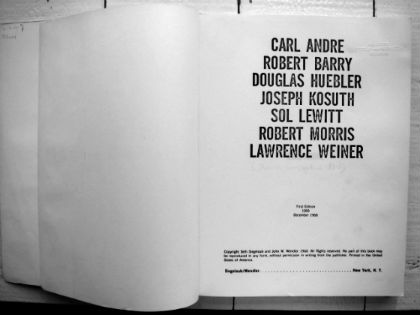Now you can xerox your own Xerox Book. In collaboration with the non-profit Primary Information, Seth Siegelaub, the do-it-all curator, writer, and art dealer, just released half a dozen of his essays and art projects from the late 60's and 70's for free download. It's all part of Primary Information's new Seth Siegelaub Online Archive and it will be expanding in the months to come. Siegelaub's interest in conceptual artists and how they can make a living from ephemeral and reproducible materials remains incredibly fresh, particularly in light of the Occupy Movement.
Siegelaub and Primary Information first began collaborating in 2008, when Primary Information approached Siegelaub about reproducing The Artist's Contract, a legal document about artists' rights, as a PDF for download. The work was included in their exhibition on the Art Workers' Coalition for PS1. According to Miriam Katzeff, co-founder of Primary Information, Siegelaub became interested in releasing more of his archives to a wider audience, viewing PDFs as a new form of artist's multiple, but still completely different from the original. While Xerox Book was published in a limited edition and cannot be reproduced without written permission, the online version can be downloaded and distributed by anyone.
The essays and projects available on Primary Information include Siegelaub's greatest hits: the Xerox Book (1968), where he commissioned artists like Carl Andre, Sol LeWitt, and Robert Morris to make art that would fit on the size of a sheet of paper; The Artist's Contract (1971), a legal document that can, to this day, be used in part or full by any artist to create their own working contract; and One Month (1969), where he asked 31 artists to create an artwork for each day of March and then created a catalog out of their written responses. For more about The Artist's Contract and the Xerox Book, see below:
The Artist's Contract (The Artist's Reserved Rights Transfer and Sale Agreement), 1971
- Co-written with a New York lawyer, Bob Projansky, the 3-page document includes demands for artists that have become more common since 1971, like the assurance that a collector will take care of an artwork according to artist's intentions. The rights stated in this document are meant to give artists some control over what happens to an artwork once it's been sold, ensuring that artists can maintain some element of copyright over their work. These rights include artist royalties, indications of who owns the work if it's re-sold, and the right to borrow the artwork every five years for exhibition.
- The Xerox Book has become a staple of Conceptual art, defining art in terms of systems, but it's also a project that defined the role of the curator as someone who, quite simply, tells artists what to do. In conversation with Hans Ulrich-Obrist for A Brief History of Curating, Siegelaub said that the Xerox Book “was the first where I proposed a series of 'requirements' for the project, concerning the use of a standard size paper and the amount of pages…In fact it was the first exhibition where I asked the artists to do something, and it was probably somewhat less collaborative than I am now making it sound.”



Comments on this entry are closed.